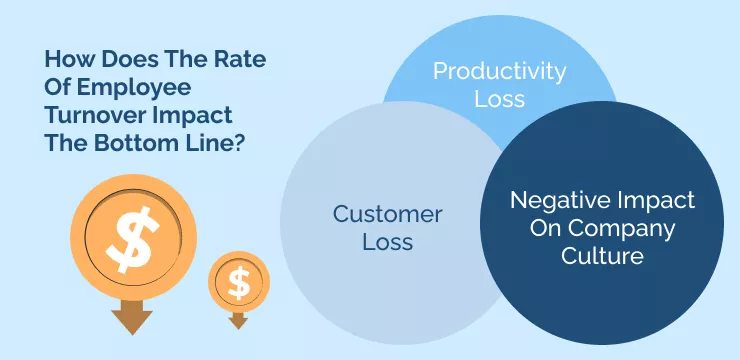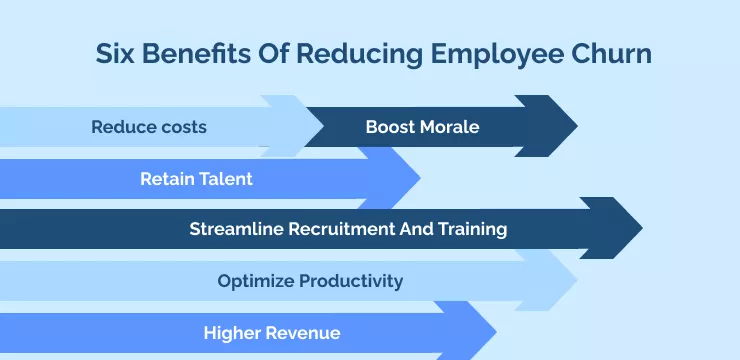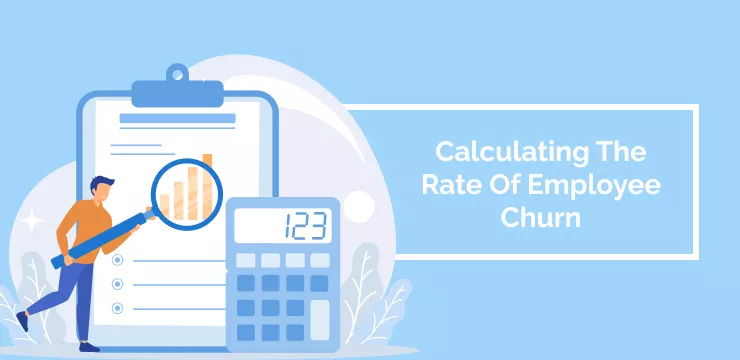
Staff turnover rate or employee churn has always been an issue for businesses. This scenario is the case today more than ever due to market uncertainty and competition to acquire talent. As a result of the pandemic, Gartner has predicted that the turnover rate would increase by 20%.
However, businesses can create an environment to keep employees motivated and happy to remain at their employer as they encounter a positive employee experience. Organizational changes are inevitable, but employers should use them to their advantage by communicating openly and frequently with employees. This can help them understand the reasons behind the changes and address any concerns they may have.
But what is the difference between churn, attrition, and turnover? How does turnover impact the bottom line? And what are the best strategies to ensure staff are loyal and remain happy and productive?
We will explore all of these questions, beginning with defining terms.
What Is The Difference Between Employee Attrition, Churn & Turnover?
The attrition rate, churn, and turnover are all similar terms that industry staff often use interchangeably. However, understanding these significantly different terms will help your business improve retention rates as you address why employees leave.
Churn rate
Employee churn is the portion of the workforce who leave an organization through voluntary churns, such as attrition or turnover over a set period. Churn rates can be involuntary, such as layoffs, or voluntary, like quitting. It’s essential to watch your company’s employee churn rate because it affects productivity, business performance, and growth.
Attrition rate
Attrition among employees is a natural process that every business will go through; it is not a negative reflection on the company. Attrition data include statistics for employees leaving for various reasons: they might relocate, retire, or have family obligations. But their reason for leaving a company isn’t because of an issue with the employer. It is simply a fact of business life.
Turnover rate
The average employee turnover rate refers to when staff members leave the company due to termination, finding a new job, or not believing they can grow their career with their current employer. These reasons for an employee’s departure are examples of voluntary turnover. Employee churn due to turnover usually means that the company needs to fill the vacant position quickly.
The difference between these terms is that churn is an umbrella term that includes a company’s attrition rate and turnover. Attrition is a natural process that every company will undergo in losing staff. But the turnover rate is very different from attrition. Turnover represents avoidable staff losses that result from poor business performance leaving the team feeling that they have no choice but to depart from their current employer, resulting in a high employee turnover rate.
As a result, companies must focus on turnover rates to improve employee retention and reduce churn to improve business outcomes.
What Is Employee Churn Rate?

The employee churn rate is the percentage of employees who leave a company in a given period. For example, if a company has 1000 employees and 150 left in one month, the employee churn rate would be 15% for that month.
Organizational development theories suggest that developing a positive employee experience is key to reducing turnover. This involves creating an environment where employees feel valued and listened to, allowing them to grow and contribute to the organization’s success. Such efforts can include regular performance reviews, training opportunities, and open communication practices to reduce the rate of churn.
Specific tech-driven industries, such as the computer games industry, have higher churn rates due to the stresses and pressures of the job. Companies must do what they can to reduce churn rate to save resources and retain talent for growth opportunities, a better bottom line, and outstanding customer perception of the organization.
How Does The Rate Of Employee Turnover Impact The Bottom Line?

How much does it cost when an employee leaves? It depends on the employee’s role, the reason for leaving, and other factors. If a company has to replace a $100k salary employee, they often spend 6-9 months of that salary, which equates to anywhere from $50k-$75k in finding a replacement.
This figure will seem surprisingly high to many team managers, HR managers, and CEOs. However, it is easier to see where this sum comes from when we break down the statistics.
There are many hidden costs to include in the price of losing staff. The first of these is productivity loss.
Productivity Loss
Productivity plummets when a key employee departs, leaving their workload behind. This action could be incredibly challenging if the individual had specialized skills that make it time-consuming to recruit talent of a similar level.
When an employee with a specialized skill set or knowledge base leaves your company, all projects they were responsible for will abruptly halt until you can find a replacement, even if other people in the organization have similar skills. On top of their regular duties, this added workload will result in delays that cost your business both time and money.
Customer Loss
Losing an employee can be detrimental to a company, as it could mean losing access to their client list or the relationships they built with customers. With a no-compete clause in place, there’s always the risk of customers leaving if their preferred team members leave the company for another business.
New hires might also make costly mistakes experienced employees would not have made, resulting in poor customer experiences and lost business opportunities.
Negative Impact On Company Culture
Seeing staff leave frequently makes them more concerned about their role and the status of the company their work within. Observing frequent departures can increase staff turnover as people are likelier to behave less rationally when they feel their livelihood is vulnerable, leaving a company because of the stress of high employee turnover rates.
The situation means that the processes and resources needed to replace staff are doubled. Costs include training, employee onboarding, and giving new team members time to acclimate to their new environment. The costs of these processes are lost from the previous employee if they move within a year. All these reasons make losing staff a costly experience for companies, which is why organizations should avoid them.
Organizational conflict can have a serious impact on the employee turnover rate. Poor communication and conflict between managers and employees make them more likely to leave the organization. This can be addressed by building a strong team culture and ensuring that managers are properly trained on conflict resolution strategies.
On the more positive side of employee churn, there are many benefits to reducing your company’s churn rate.
Six Benefits Of Reducing Employee Churn

There are many benefits to reducing turnover rates as part of efforts to tackle employee churn. The first of these benefits is the reduction of business costs.
- Reduce costs
The largest US firms spend millions of dollars annually on the recruitment and hiring process to replace employees. The costs involve screening, interviewing, and advertising, and the market for staff is highly competitive, so these costs are continually increasing. Onboarding costs such as training and management oversight add to this lost revenue.
When companies reduce churn, they save money they can invest in maintaining connections with existing staff, leading to growth opportunities and better outcomes.
- Boost Morale
When staff constantly see colleagues depart, it damages morale. The existing team loses connections and takes on higher workloads, which can affect work-life balance and make them consider leaving.
Effective employee retention processes boost morale, optimizing connections and employee engagement, creating an environment in which employees enjoy working and want to stay.
- Retain Talent
Institutional knowledge loss and lost skills, crucially relationships, affect staff turnover rate. Organizations depend on the relationships between customers and staff and connections between staff to ensure positive business outcomes.
When companies prioritize churn, they retain top talent and the skills, connections, and institutional knowledge that take so long to build.
- Streamline Recruitment And Training
When organizations focus on employee retention, they save massive amounts of resources. After an organization invests resources in training qualified employees, if the employee leaves, all progress is lost. Another cost-saving method is recruiting internally, as it costs less to train and reskill someone who already knows the company culture. In addition, companies can retain staff by supporting them throughout the employee life cycle, from the onboarding stage to exit interviews.
- Optimize Productivity
High turnover rates have significant consequences for employers, the most notable being a loss of employee productivity. On average, it takes a new hire up to two years to reach the same level of productivity as an existing employee.
In addition, new hires need time to build relationships with peers and customers. Moreover, an understaffed environment creates more problems: employees working overtime until burnout, lower quality work overall, and delays in completing projects.
Keeping productive employees is crucial for any organization. Productive workplaces have more engaged workers and improve client relationships and customer experience. Therefore, teams working effectively together tend to be more effective.
- Higher Revenue
There are several benefits to maintaining employee loyalty, such as reduced hiring costs, increased productivity, and improved customer experiences. To understand how much loyalty programs influence your company’s financial bottom line, track the revenue increases from these policies. Doing so will serve as a critical HR metric to show how effective retention initiatives can be.
Although it requires many resources, companies that wish to keep their best employees require retention strategies, tools, and processes. The reward for this effort is maintaining a pool of exceptional talent.
If an organization does not focus on employee retention, it may lose money from finding new employees and training them. Also, the company will suffer productivity loss as it creates a negative corporate culture. Customers and employees are also more likely to have negative experiences, weakening their loyalty to the company.
Reduce Churn Rate To Improve Employee Retention In 4 Simple Phases

It is essential to reduce the annual turnover rate to improve the retention of existing staff. But what strategies can companies use to achieve this goal?
- Identify common problems leading to churn
Identifying the causes of employee churn is essential to reduce turnover rates. Many causes of employee turnover include poor management, lack of development opportunities, and low pay. Define how these problems relate to your organization to build a plan to find solutions and improve retention by creating a positive environment for staff.
- Compare your retention strategies to competitors’
What strategies are competitors utilizing to reduce churn? Could your organization adopt a similar approach? Monitor staff retention approaches of others in your industry, then implement an optimized version of their strategy to the advantage of your company and staff. You can do this by offering existing and incoming staff better benefits than competitors or filling in gaps they don’t tackle. This approach can promote retention as employees feel they are getting a good deal in their benefits package.
- Identify weaker employees early
Although it seems to counter the concept of keeping staff, firing staff early, who are not helpful to the company, is essential to reducing churn. The rationale is that employees with negative attitudes make those who contribute positively leave. Removing bad-fit employees early in the process can reduce wasted resources and avoid disruptions to company culture.
- Offer internal progression and transition opportunities
When building a churn reduction plan, ask several questions about current practices. Does the current onboarding process have any issues that could you could streamline? How does your company onboard staff and make them feel comfortable and welcomed?
Reviewing your recruitment and onboarding process periodically to ensure that it attracts the right employees and sets the right expectations is essential. This action can help reduce employee turnover in the long run.
Imagine you hire somebody who wants to work the typical 9-5 software developer job. But when they begin their new role, they’re expected to do copywriting, graphic design, and business process optimization between 8 am – 6 pm. They might quit due to frustration if the company does not clarify the job’s expectations.
Another strategy to assist you in reducing churn is calculating the employee churn rate as a baseline for improvement.
Calculating The Rate Of Employee Churn

Determining annual staff turnover requires two simple steps. For example, if you have 50 employees at the beginning of a year and 100 by the end, but 20 quit during that period, calculate your turnover rate for that year using these two steps.
Step One
Calculate the average number of employees during the year by adding the total number of employees at the start of the year to the total number of employees at the end of the year, then dividing that sum by two.
For example: (50 + 100) ÷ 2 = 75
Step Two
This employee turnover calculation is versatile; you can apply it in any time frame that you find helpful for your metrics. Divide the number of employees who left during the year by the average number of employees that you calculated in step one.
For example, if twenty employees left and the average number of employees was 75, you would have a 26% turnover rate ((20÷ 75) × 100 = 26%).
You can easily tailor this employee turnover calculation to fit any period. Rather than limiting yourself to annual turnover, you could also measure quarterly turnover. This process is beneficial if you work in an industry with a high turnover rate, such as sales. Adjust the time frame that works best for your company’s needs to achieve the desired result.
Case Study: Businesses That Have Successfully Reduced Employee Churn
It’s helpful to look at the practical outcomes of large businesses to see how effective churn reduction strategies work. Netflix is an excellent example of a successful churn reduction strategy.
- Netflix: A-players
Since Netflix started with DVD rentals that developed into its streaming technology over time, innovation has been part of its identity. In the last ten years, Netflix has helped cable, video rental, and VOD spaces evolve into streaming, influencing the world’s digital adoption of streaming technology. So when Patty McCord, the company’s first Chief Talent Officer, began her role, she placed innovation at the top of her list of priorities regarding talent acquisition and churn reduction.
Her innovative yet practical style disrupted the business world, and the industry recognized the culture deck she created with Netflix CEO Reed Hastings as a critical document of Silicon Valley. Patty McCord describes one of her primary principles in SnackNation when reducing churn: “Take care to only hire A-players by focusing on [employee] character in the hiring process.”
According to conventional wisdom, your organization will always have a clear hierarchy. Great hires such as A-players are at the top of this hierarchy, and so McCord decided to strive only to hire the highest-performing staff who offer results and innovation.
There are two primary benefits to the company of hiring more A-players – not only are these individuals more productive and motivated, and they create a better working environment for everyone. A better working environment means lower churn and a more robust bottom line.
This process of A-player recruitment for better outcomes and lower churn resulted in Netflix breaking rival network HBO’s 17-year Emmy winning streak. This result shows that lower churn gives better business outcomes, making staff feel they are on a winning team and reducing the desire to leave.
- Wholefoods: Values-driven culture
Researchers note that CEO John Mackey primarily uses the service and values leadership models, with slight traces of Japanese management philosophies. His focus is on creating a sense of purpose for employees.
Mackey established Whole Foods’ purpose in the company’s core values, which include “Support Team Member Excellence and Happiness” and “Serve and Support Our Local and Global Communities.”
The company’s success in attracting and retaining the right employees is due to its strong sense of purpose, which filters down from management to all levels of the organization. When employees feel the benefits of their organization in their role, they are more likely to practice them, leading the company to success and staying with them for longer.
Tackle Turnover, Reduce Churn
Employee churn is a complex and multifaceted problem driven by attrition and turnover, but it’s one that every business needs to address. By understanding the causes of turnover, you can build a strategy to reduce churn.
Your churn rates will always be unique to your company, but by investing time in lowering them, you’ll see a positive impact on your company’s bottom line.
Tristan Ovington
Tristan Ovington is a professional senior writer and journalist, specializing in providing expert insights on various topics such as digital adoption, digital transformation, change management, and Cloud apps. He delivers his knowledge through accessible online content that is data-driven and presented in a friendly tone, making it easy for readers to understand and implement.



